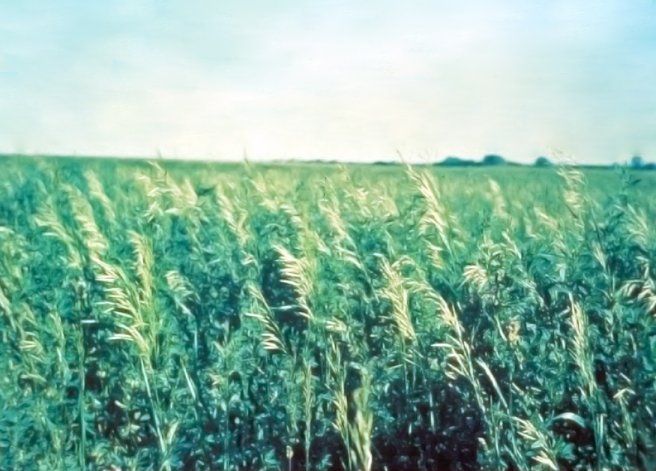
By Bruce Anderson, UNL Forage Specialist
Planting new fields of pure alfalfa sometimes gets to be too automatic. Maybe it’s time to consider adding some grass to the mix.
Let’s look at some of the advantages for including grass with our alfalfa plantings:
1. Grass may grow in areas of the field where alfalfa plants are not well-adapted.
2. Grass may fill in spots as alfalfa plants die rather than weeds so acceptable yields may persist longer.
3. Grass-alfalfa mixtures dry faster than pure alfalfa.
4. Grass forage quality declines more slowly than alfalfa during second and later cuttings because grass regrowth is mostly leaves.
5. Grass suffers less damage from wheel traffic of harvest equipment or manure spreaders.
6. Grass sheds rainfall better than alfalfa, both in the windrow and in the bale.
From an animal nutrition perspective, adding grass to alfalfa also has some advantages:
1. Grass-alfalfa mixtures come closer than pure alfalfa to meeting the desired TDN:CP ratio of 5-7.5:1 for beef cows on high roughage diets.
2. Grass adds more potentially needed fiber than alfalfa for high grain or corn silage diets.
3. Grass can reduce acidosis in dairy rations without impacting milk production by lowering non-fiber carbohydrates.
4. Bloat risk is less when grass is part of the pasture mix.
Of course, including grass with the alfalfa adds some management challenges. Selecting the initial seeding rate to achieve a desired balance of grass to alfalfa is difficult. Basing the seed mix on seeds of each species per square foot is one way to start. For example, assume a 60:40 mix of alfalfa to orchardgrass is desired. Most seeding rate recommendations for mixtures of cool-season species range from 50 to 80 seeds per square foot. Using 70 seeds per square foot for the example, a seed mix containing 42 seeds of alfalfa and 28 seeds of alfalfa will give the desired 60:40 ratio. If one pound of alfalfa seed provides 4.8 seeds per square foot and one pound of orchardgrass seed provides 6.4 seeds per square foot, then a mix of 8.75 pounds alfalfa plus 4.375 pounds orchardgrass per acre will give the desired seed mix. Seed size can vary substantially so determine the seeds per pound of the specific seed to be planted if this seed ratio method is to be used with precision. From a practical standpoint, however, using average seed size values will do just about as well.
Planting date will affect the ratio. The optimum temperature for alfalfa seedling development is as much as 15 degrees warmer than that for grasses. Planting in early spring will favor grass while planting in late spring or late summer will increase alfalfa.
Chemical weed control is severely limited when grass is grown with alfalfa. Most herbicides will cause significant injury to either the alfalfa or the grass.
Most of the grass yield likely will come at first harvest. This could be advantageous if some nearly pure alfalfa is desired as well as an alfalfa-grass mixture. The amount of grass in regrowth will depend greatly on the grass species. Smooth bromegrass and timothy produce little summer growth. Tall fescue, meadow fescue, meadow brome, orchardgrass, and festulolium give a more uniform balance through the growing season. Variety selection also is important, especially if hay harvests are planned. Late maturing grass varieties usually match up best with alfalfa.
Fertilization can have important impacts on the ratio of alfalfa to grass. Nitrogen usually will increase the proportion of grass while phosphorus and potassium sometimes can increase the amount of alfalfa in the mix.
Other challenges may come from attempts to market hay of a mixture of grass with alfalfa to dairies or other customers that prefer pure alfalfa. Some potential customers, though, may like having some grass in their hay. Grass also is more difficult to grind, which also could influence its use.
Despite these challenges, it is worth considering when new hay fields are planted.
Reprinted with permission from Forage Grower Extra
http://www.progressiveforage.com